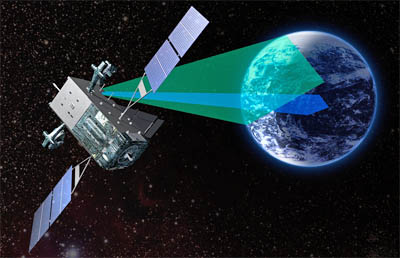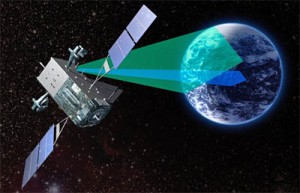

SBIRS GEO satellites have the ability to stare at a specific spot on the globe (Credits: Lockheed Martin).
Atlas 5 rocket is almost ready for a missile-warning spacecraft, after already successfully carrying out two satellite launches since the beginning of the year.
“I don’t think everyone realizes what all is involved in launching 2 Atlas 5s, one off the East Coast, one off the West Coast, 11.5 days apart,” said NASA launch director Tim Dunn.
The Atlas 5 stacked in Cape Canaveral will carry into orbit the 2nd Space Based Infrared System Geosynchronous satellite (SBIRS GEO 2), on March 19. SBIRS GEO 2 will join the Air Force’s constellation of missile launch detection observatories flying 35,900 kilometers above Earth, providing a constant watch for incoming menaces. SBIRS GEO is the next-generation system, built by Lockheed Martin to replace the Defense Support Program (DSP) satellites. The new spacecraft’s payload offers an increased sensitivity, replacing the DSP scanning infrared telescopes. The sensors on these satellites can detect infrared emissions from intense sources of heat like missiles, spacecraft launches, and nuclear explosions. SBIRS GEO 1 was launched in May 2011. The current constellation of SBIRS, in geosynchronous, highly elliptical, and low Earth orbit, is composed of 6 satellites, launched between 2006 and 2011.
The satellite arrived in Florida on January 11 and it is now undergoing final testing. It will be moved to the Vertical Integration Facility (VFI) to be placed into the Centaur upper stage in early March. The last stage completed the Atlas 5 stacking in VFI on February 18.
This year’s earlier Atlas 5 launches put in orbit the Tracking and Data Relay Satellite K (TDRS-K) on January 30, and the Landsat Data Continuity Mission spacecraft, on February 11. TDRS-K’s launch was preceded by the quickest-ever pre-flight campaign with just 27 days from the start of buildup until liftoff. The Landsat launch was the 1st Atlas 5 to take off from Vandenberg Air Force Base in California.
United Launch Alliance scheduled eight Atlas 5 launches for 2013. These launches include three more for the U.S. Air Force, one classified for a National Reconnaissance Office mission, and NASA’s Mars Atmosphere and Volatile Evolution (MAVEN).

















































































































![A trajectory analysis that used a computational fluid dynamics approach to determine the likely position and velocity histories of the foam (Credits: NASA Ref [1] p61).](http://www.spacesafetymagazine.com/wp-content/uploads/2014/05/fluid-dynamics-trajectory-analysis-50x50.jpg)



Leave a Reply